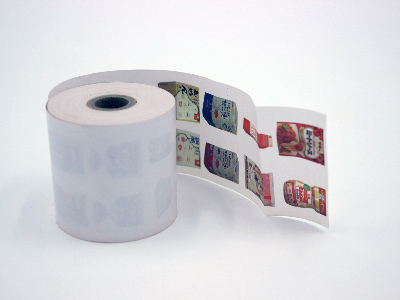In our daily life, we all come into contact with thermal paper, such as cash register receipts, instrument records, etc. Unlike ordinary paper, thermal paper uses heat to create an imprint without the use of ink or ribbon. So how does it do this? This article will introduce in detail how thermal paper works and how to achieve inkless printing.

How Thermal Printers Work
A thermal printer is a device that uses thermal paper for printing. Its working principle can be simply summarized as follows: heating the roll-shaped thermal paper to make it chemically react and display patterns or characters. Specifically, it consists of the following four steps:
1. Signal input: The user inputs printing information through a computer and other equipment, and the information is transmitted to the thermal printer through a data cable.
2. Heating element heating: The heating element in the printer starts to heat after receiving the signal, and writes the pattern or text information on the thermal paper.
3. Chemical reaction: When the thermal paper is heated, the chemical dye triggers a chemical reaction, making it discolored or blackened.
4. Display: the pattern or text appears on the thermal paper, and the printing is completed.
The principle of realizing inkless printing
The principle of thermal paper to achieve inkless printing is to use a property called thermochromism. Thermochromic materials refer to substances that change their visible spectrum by heating within a certain temperature range.
In thermal printers, thermal paper usually consists of two layers, one of which is the photosensitive layer and the other is the protective layer. When the heating element heats the thermal paper, the thermal dye in the photosensitive layer will be heated to its reaction temperature, so that a chemical reaction occurs, the color changes, and an imprint is formed. The thermotropic dye will decompose and react into a certain colored product, which can be selected according to the reaction temperature, molecular structure, etc., so that the output display is beautiful and the contrast is high.
Therefore, the reason why thermal paper can achieve inkless printing is that the thermal dye can undergo a chemical reaction after being heated within a certain range, and this discoloration effect can be maintained for a long time, thereby achieving long-lasting imprinting.
Summarize
Thermal paper achieves inkless printing through the principle of thermochromism, and its working principle has simpler and more direct advantages than traditional inkjet printing and laser printing. At the same time, since thermal paper does not need to use ink or ribbon, it also reduces the maintenance and replacement costs of hardware equipment, making thermal printers widely used in commercial, medical, scientific research and other fields.
Copyright © Suzhou Guanhua Paper Factory All rights reserved.